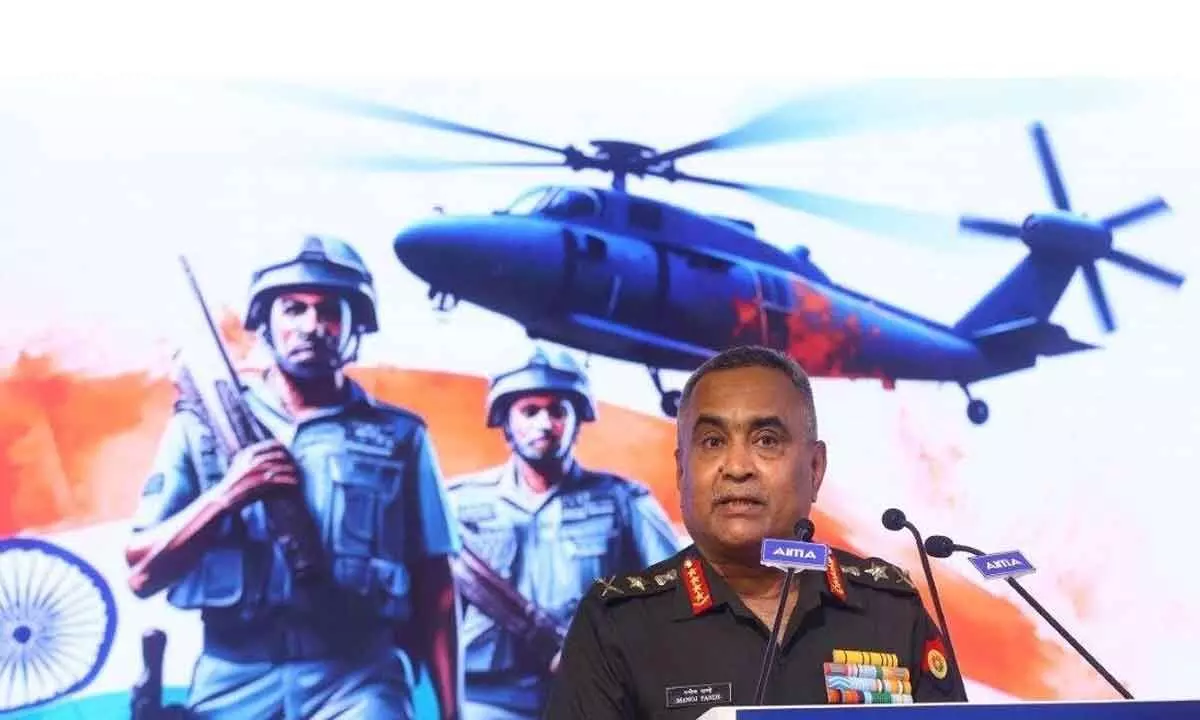‘Military strength, capabilities necessary to prevent wars’
Share :

Army’s vision for the future is to transform into a modern, agile, adaptive, technology-enabled and self-reliant future-ready force, “capable to deter and win wars in a multi-domain operational environment, across the full spectrum of operations, to protect our national interests, in synergy with the other Services”.
New Delhi: The current geo-strategic landscape is characterised by a change that is taking place at an “unprecedented” scale and speed, Army Chief Gen Manoj Pande said on Tuesday while asserting that military strength and capabilities are necessary to prevent wars. Recent geopolitical powerplays have displayed, that where national interests are concerned, countries will “not hesitate” to go to war. These developments have reaffirmed the relevance of hard power, he said this during an event here.
The Army chief took part in the AIMA National Leadership Conclave and spoke on ‘Hard Power: Modernising Forces through Self-reliance’. He said the overall rise of a nation can be said to occur when there is a significant and continuous increase in its “comprehensive national power”. While “economic power” is the fountainhead of the growth of the nation, it is the “military strength” that lends it the ability to “affect the outcomes”, necessary to protect and further its multifarious interests, in expanding strategic horizons, the Army chief said.
The current geo-strategic landscape is characterised by change, taking place at unprecedented scale and speed. Recent geopolitical powerplays have displayed, that where national interests are concerned, countries will not hesitate to go to war. These developments have reaffirmed the relevance of hard power, Gen Pande added.
Military strength and capabilities are necessary to prevent war or to present a “credible deterrence” as well as to enable a robust response to threats and winning wars, when required, across the “entire spectrum of conflict”, he said. He also underlined the factors in play in shaping hard power capabilities, through ‘atmanirbharta’ or self-reliance. The unprecedented trends in the geo-strategic landscape, the limitless potential of disruptive technologies, the transforming character of modern wars and the profound changes in the socio-economic domain, are the four key drivers of the Indian Army’s transformation efforts, the Army chief said.
In the country’s quest to achieve and sustain a ‘hard power’ quotient, “we need to be alive to the implication of external dependency to meet defence requirements”. The impact of supply chain disruptions and weaponisation of denial regimes came to the fore, during the pandemic and also from the lessons of the ongoing Russia-Ukraine conflict, he said. “These developments have underscored that the security of the nation, can neither be outsourced nor be dependent on the largesse of others. In the context of capability development, if we are import-dependent for critical technologies on countries that possess them, we must be very clear that we will always remain one technology cycle behind,” Gen Pande added. He asserted that the Army’s vision for the future is to transform into a modern, agile, adaptive, technology-enabled and self-reliant future-ready force, “capable to deter and win wars in a multi-domain operational environment, across the full spectrum of operations, to protect our national interests, in synergy with the other Services”. The transformation roadmap entailed five pillars -- force restructuring and optimisation, modernisation and technology infusion, improvement of systems, processes and functions, human resource management, and promoting jointness and integration with the sister Services, he said. The Army is pursuing new and niche technologies, for absorption into warfighting systems. This is being given effect, through a focused capability development and sustenance roadmap, which conforms to the force’s commitment to the vision of ‘atmanirbharta’, the Army chief said. He underlined that to achieve ‘atmanirbharta’, it is essential that an effective defence-industry ecosystem is created in the country.
The foundational building blocks, for developing the desired defence-industry ecosystem are resource allocation, enabling government policies and provisions, viable market and competition. The key areas for technology infusion span across all domains of warfare. Towards improving mobility and protection, procurements include light strike vehicles, all-terrain vehicles, light specialist vehicles and bulletproof jackets, the Army chief said. Battlefield situational awareness is being enhanced through border surveillance systems and nano drones. For target acquisition and precision fires, “we have swarm drones, loiter munitions and new artillery platforms such as 155mm MGS, TGS, K9 Vajra, ATAGS, and new generation munitions, which are terminally guided or canister launched”.
Night fighting capability is being enhanced through night sights for small arms and hand-held thermal imagers. The effectiveness of communication is being upgraded through software-defined radios, he added. The army is also deploying terrain-specific electronic warfare systems, drones and anti-drone systems. Logistic capacities and efficiencies are being augmented by employing logistic drones. Induction of new weapon platforms for mechanised forces “such as Light Tanks and Future Infantry Combat Vehicle and Army Aviation such as Medium Altitude Long Endurance RPAS and LUH are in the pipeline”, the Army chief said. Apart from weapon systems and equipment, “we are pursuing 45 niche technologies” which have been identified for military application, he said, adding that 120 indigenous projects are underway to develop and absorb these niche technologies. “’Indigenise to Modernise’ shall remain our mantra for capability development. Army’s ex-imports defence contracts, which 20 years ago stood at 30 per cent are at near zero per cent for the last two financial years. “Presently, our inventory contains a mix of vintage, current and state-of-the-art equipment. We intend to scale up the ratio of vintage:current: state-of-the-art equipment substantially by 2030 with a focused ‘atmanirbhar’ capability development roadmap,” he added.













